Improving Online Luggage Stores' Conversion Rate: 12 Data-Backed Ideas


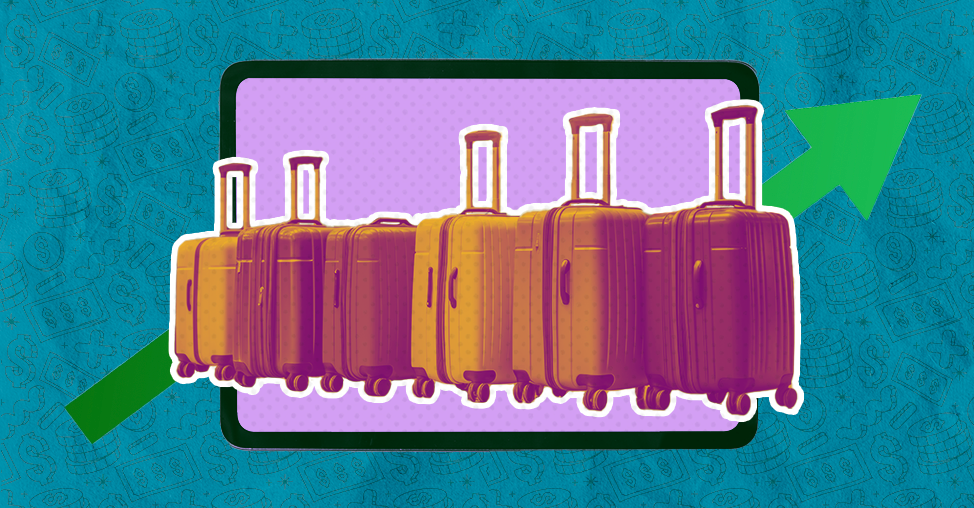
The good news is that the discerning luggage buyer is happy to spend — and happy to spend a lot on a product that comes with excellent after-sales service & warranty.
What’s not such good news is that if a buyer like this sees poor navigation on a baggage store or filters that don’t match their buying requirements, they will bounce faster than you can say “stop!”
The gap in between is what we’re here to bridge with this piece here — because it features advice we’ve gleaned from across eCommerce luggage brands that deserve a medal as well as audits & A/B tests we’ve performed.
Looking to raise your luggage conversion rates steadily and sustainably? Look no further because here are 12 ideas we’ve tested and seen results from.
1. Resolve fit uncertainties through clear sizing visualizations
2. Create dedicated content for material & durability storytelling
3. Target frequent travellers with smart bundling
5. Train your live chat to offer comparison info
6. Run a superior post-purchase service to resolve anxiety
7. Feature buyer guides that address real-life concerns
8. Set up seasonal luggage pages for gifting
9. Upsell & cross-sell with the most relevant add-ons
10. Create dedicated blogs on new launches
11. Turn the homepage into a hero product landing page
12. Run discounts for repeat customer segments
Luggage needs to fit, period. Even under circumstances where shoppers are angling at great designs and limited time prints.
But in the absence of a real-world store experience, shoppers are likely to struggle to get a sense of how a backpack will fit a certain body type or a strolley fit the overhead storage on a flight.
👉 Create guarantee badges — and then apply these across high-intent pages wherever you recommend a product. If you know the main customer objection for a suitcase would be around whether they can lug it across most carries, issue a “100% approved carry-on size.” Similarly, if sizing is likely to create more confusion despite given specs, a short callout like “packs for 7 days” can really work.
👉 Show sizing breakdowns on the product page — create barebones line drawings to show length, width, depth, while also featuring gallery images that show the product in zipped and unpacked mode. It’s always a good idea to include an image that shows the product and its specs against a real-life background (in contrast to furniture, fitting into the back of a car etc.)
Though eCommerce brand Calpak started with just handbags and wallets, it’s grown to target the heavy-duty traveler who’s ready to invest in quality luggage products. This is also why they take size visualizations rather seriously and features line drawings above the fold on product pages.
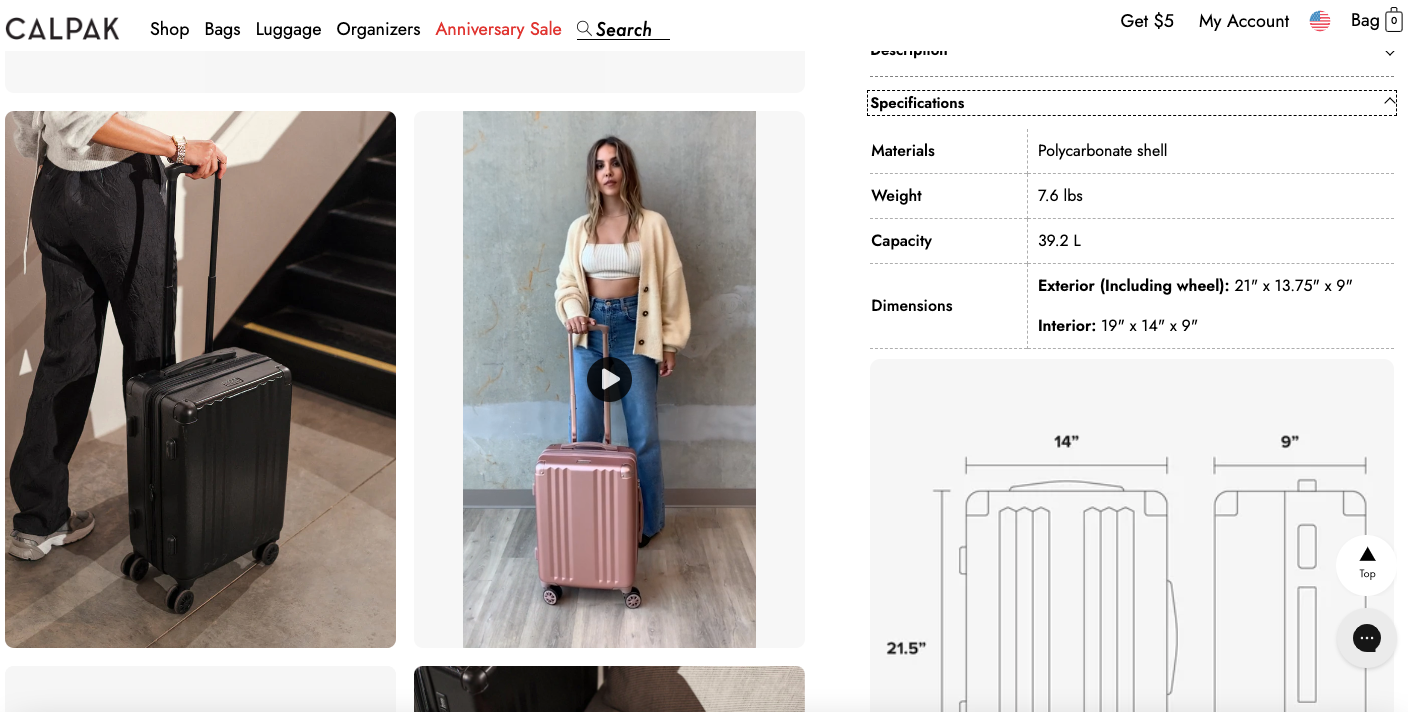
And if that’s not dynamic enough, in a later section, they highlight the main features by showcasing 10 second videos to elaborate on them:

🔥 Pro Tip: Surface 2-3 review snippets within the product info card that talk specifically about sizing. Ensure the contexts are varied so that shoppers can get a more expansive imagination around the luggage product in question.
eCommerce luggage buyers expect to know what they’re paying $600 above for.
Since luggage also typically represents longer lifecycle products, shoppers want to ascertain that they’re paying for high quality.
Something you can leverage only when you do a great job at creating content around the materials you use and the backend processes you run.
👉 Feature micro-stories in text alongside looping GIFs — talk about that aerospace-grade aluminum being used as the chief material in your carry-on baggage or state exact numbers about the tenacity of a piece of luggage (like it can withstand 500 drops).
👉 Show elaborate visual-led sections with tap-to-reveal functionalities — shoppers, including luggage buyers, dig a little mystery. So, when they can partake in this kind of engagement on the homepage and product pages, they move a little closer to considering buying from the brand — and even better, to fix their decision of buying a specific luggage product.
DTC luggage store Away has been around for a while, but even then they consider competitor sites seriously. As a result, they’ve created a “comparison” page offers dedicated content on the brand’s back-end process when it comes to create travel carry products:
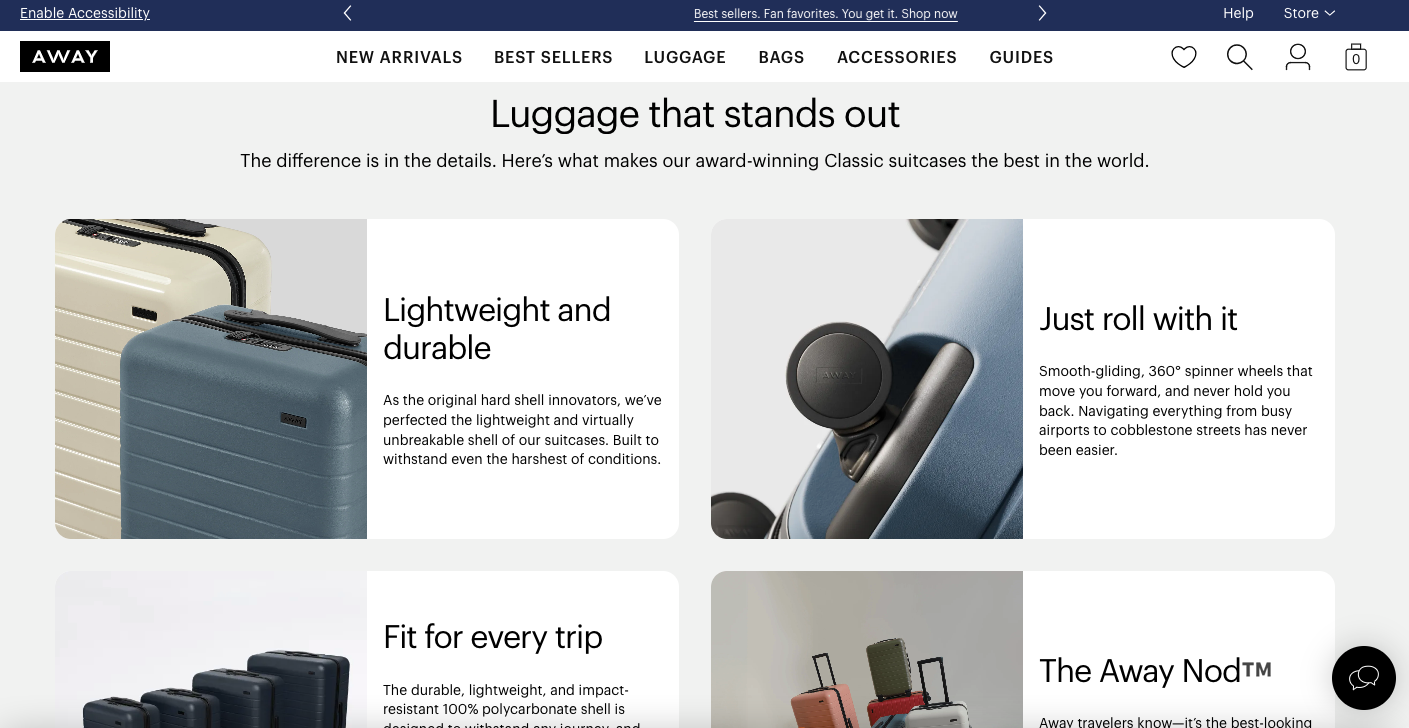
Keep Reading: 23 Key Elements Every Product Description Page Must Have (eCommerce)
Many eCommerce luggage brands we’ve audited feature bundles alright, but there’s a mistake they make: they highlight the discounts more than the precise utility that travelers will derive from them.
And to do the latter, a brand has to be supremely focused on its highest LTV segment. For many brands, this comprises frequent travelers. And, targeting them with the right bundling techniques can be your ultimate luggage store conversion booster.
👉 Curate sets that match travel cadence — look at sub-segments that are also high spenders, segments like “weekend flyers” and “long-haul travelers”, and feature bundles that are closely mapped to these needs. Feature badges like “limited edition” or “early access price” to get shoppers acting, and make sure apart from featuring them on the homepage, creating specific landing pages when you’re targeting paid traffic.
👉 Combine build-your-bundle with incremental discounts — tie it up with your loyalty program if you like, although the prime idea here is to incentivize those who’ve given you repeated sales. Auto-apply a dynamic discount when shoppers mix and match products (to ensure this doesn’t eat into your profit margin, you can set thresholding conditions like “only when you add at least 3 products”).
July is a brand that understands luggage conversion rates wildly depend on how much freedom they offer shoppers to mix and match products. The reason why they let shoppers choose from type, style and color to create unique bundles, applying a dynamic discount later in the cart:
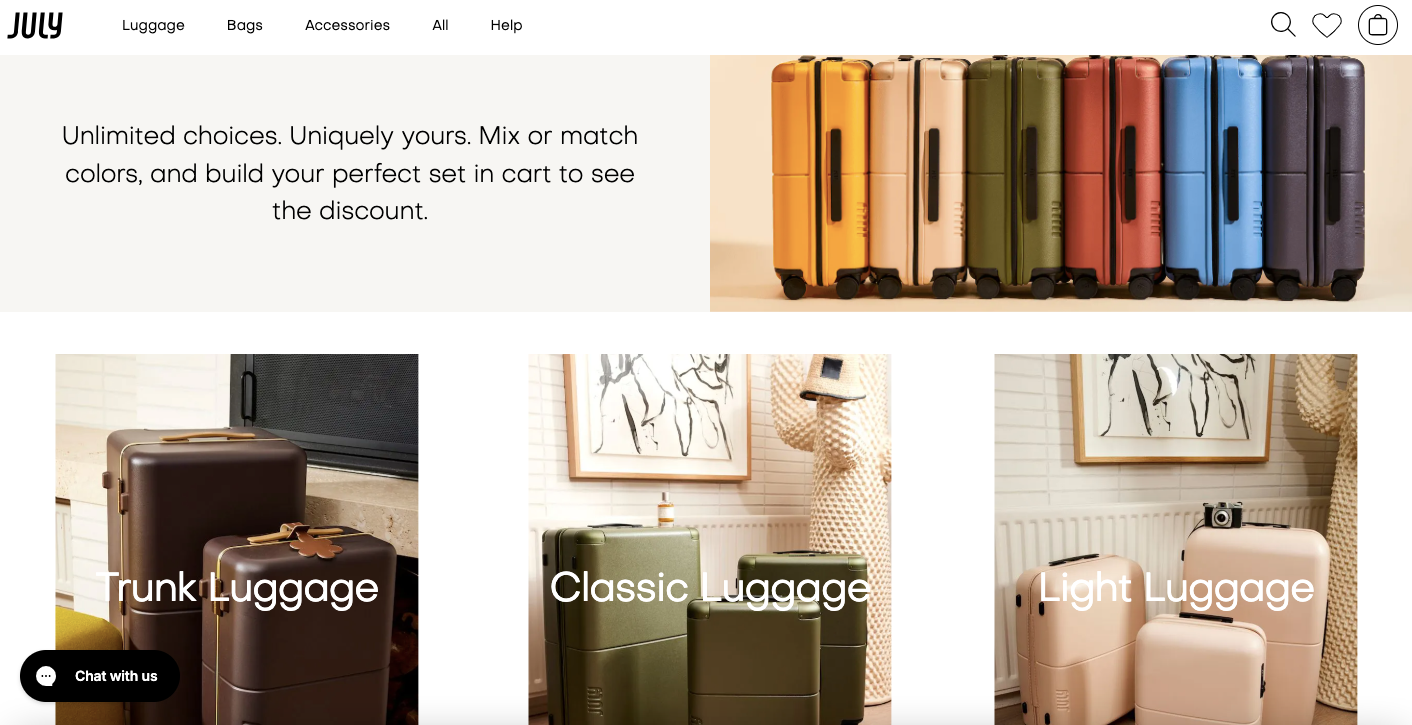
Further Reading: 15 Product Bundling Examples That Convert (& 9 Proven Ideas)
Serious travelers will pay more if you can offer something really relevant over and above the main product or bundle.
In the luggage store conversion scenario, upgrades work great in the direction of improving value per customer, but only as long as shoppers find them relevant (and relevantly placed).
👉 Include service upgrades within a higher pricing framework — most luggage shoppers love value-add upgrades like this one because they expect the product to last a long time, and when problems kick in, for the brand to support them. So, a service upgrade included within higher pricing is a win-win.
👉 Release discounted version upgrades on bestsellers (from time to time) — this can be super attractive for those who get referred by friends and family, only to discover they have to pay $X for not just the bestseller but also an add-on and free gift (first-time visitors love this!)
👉 Run a luggage trade-in campaign — since acquiring new customers within the luggage industry can anyway be troublesome for most brands, a trade-in campaign is an amazing upgrade approach. This can enable shoppers to bring back old pieces of luggage and trade them in for something newer. Apply a fixed discount or a number of points for this trade-in, and you create more luggage conversions for the future.
Monos works with trade-in campaigns to keep current customers evolving to the next level. What’s great is that the brand ensures upgrade trade-in information is available across their luggage store, including the live chat, which shoppers across the conversion funnel use:
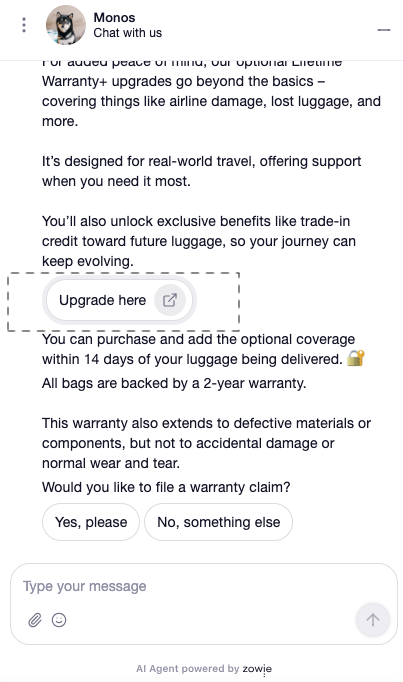
On that note, let’s talk some more on getting live chat right for luggage store conversions, shall we?
While many luggage stores do a phenomenal job at product recommendations, most miss out on offering product comparisons that’ll make shoppers sit back, pause and consider.
👉 Integrate a widget to show card comparisons — too much scrolling to compare product information can be a task for luggage shoppers and can actually lead to a high bounce rate. To resolve this, work with a widget that can show quick comparison cards of 4 to 5 pointers each on the product(s) mentioned. This also works really well for mobile luggage buyers.
👉 Create conversational filters to bring up the most relevant comparisons — this is a way to prioritize what makes up the most critical concerns for shoppers. So, the best way to do this is to create a series of questions that help shoppers narrow down their intent, questions like “What kind of trips do you do most often?” and “What airline(s) do you fly with often?”
eCommerce luggage brand ROAM has strategized this conversion optimizer by using superlative AI. Their back-end chat system is clearly fed by excellent machine learning, allowing customers to ask a variety of questions on products and even seek comparative understanding between a few of them:
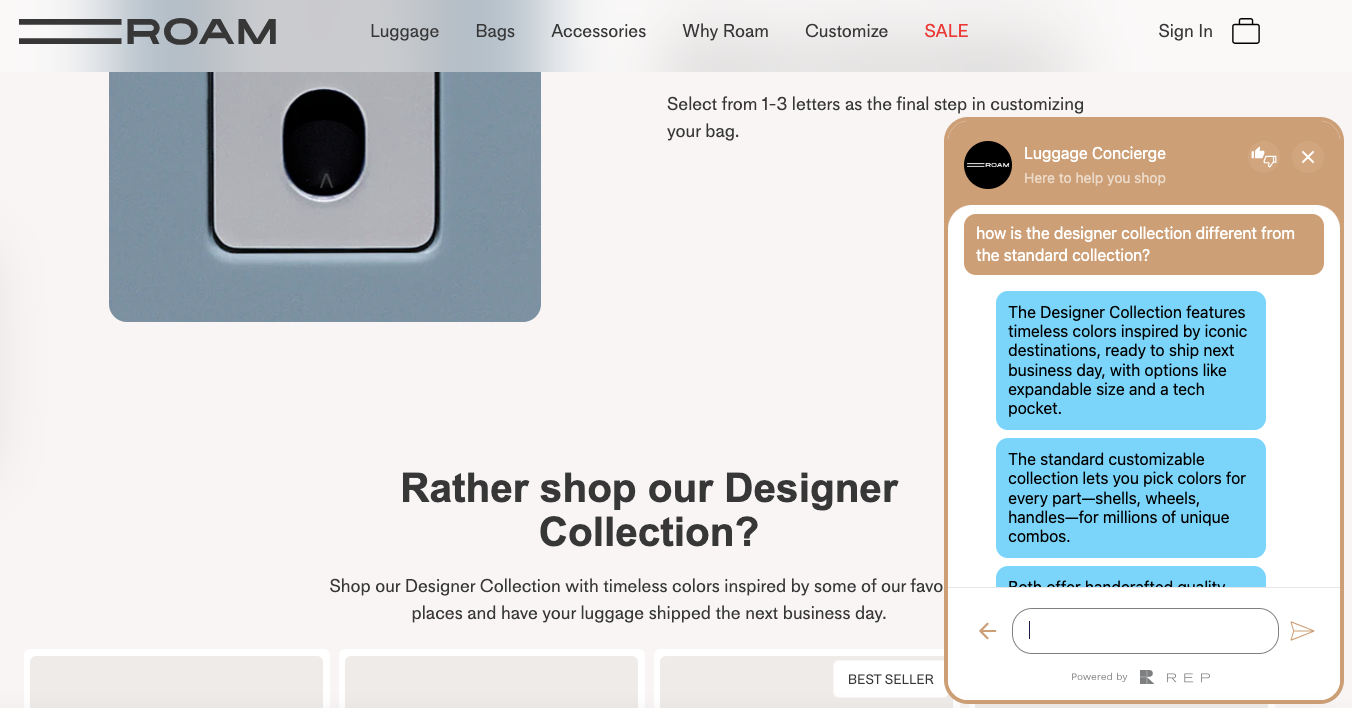
High-ticket DTC niches like travel & luggage have to pre-empt post-purchase anxiety in shoppers.
For obvious reasons, it’s way higher than if you were sending a subscription box of cookies.
What luggage shoppers are looking for, goes beyond standard order status updates and emails suggesting how to take care of the product.
👉 Flank map-based tracking with instant reassurance messages — while a link letting shoppers see the exact status of their delivery works well for all other niches, for travel and luggage conversions to continue, you have to create additional reassurances through microcopy like “Your bag’s being inspected for quality before shipping”.
👉 Show a clear progress bar of upcoming milestones — this is a valuable tool as it serves as a micro-animation to show success at every step. Color code the stages based on what’s complete and what’s yet to be completed. This is a great conversion tactic especially when you’re targeting mobile luggage conversions specifically.
👉 Set up a 72-hour concierge service — it’s about telling shoppers you care as a brand before they even reach out. This is a value-add service for which you can even lean into premium pricing for your products. If it’s not feasible to offer this to everyone who buys from you, apply it only for loyalty members or those who’ve bought at least X number of times.
Luggage brand Delsey maintains a superior after-sales service across their product lines. They maintain a detailed form for shoppers to key in their concerns, and to reduce friction also maintains a helpful list of FAQs on the service request page:
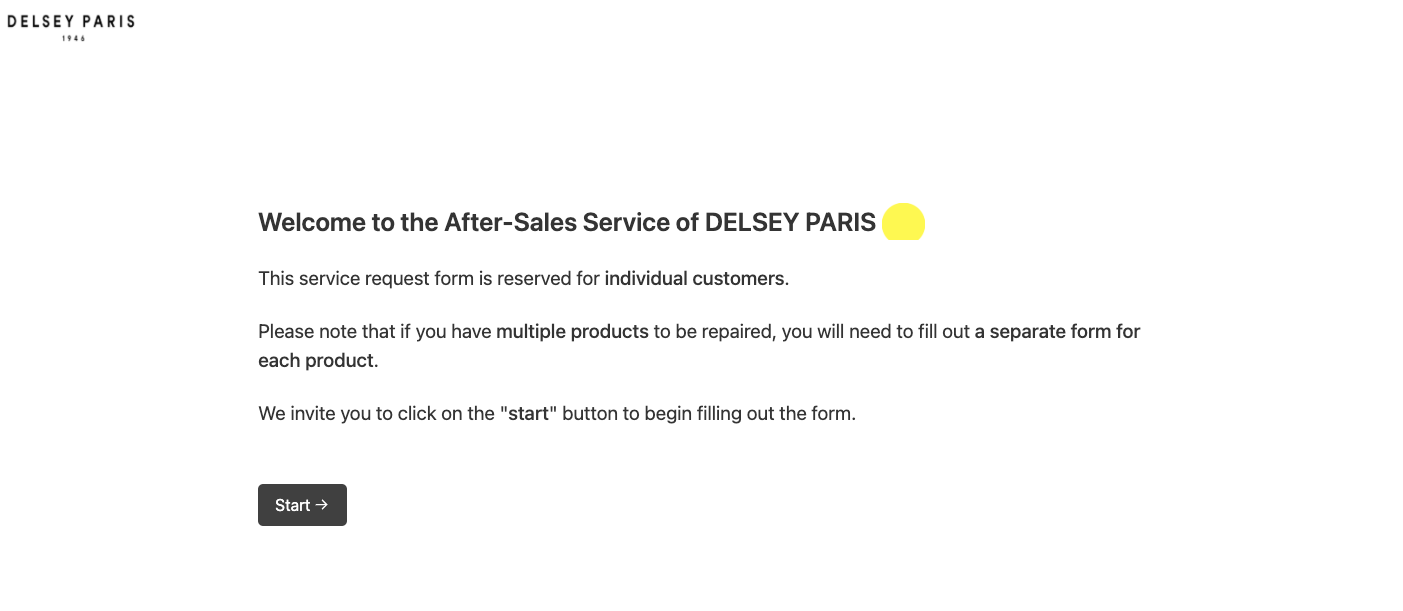
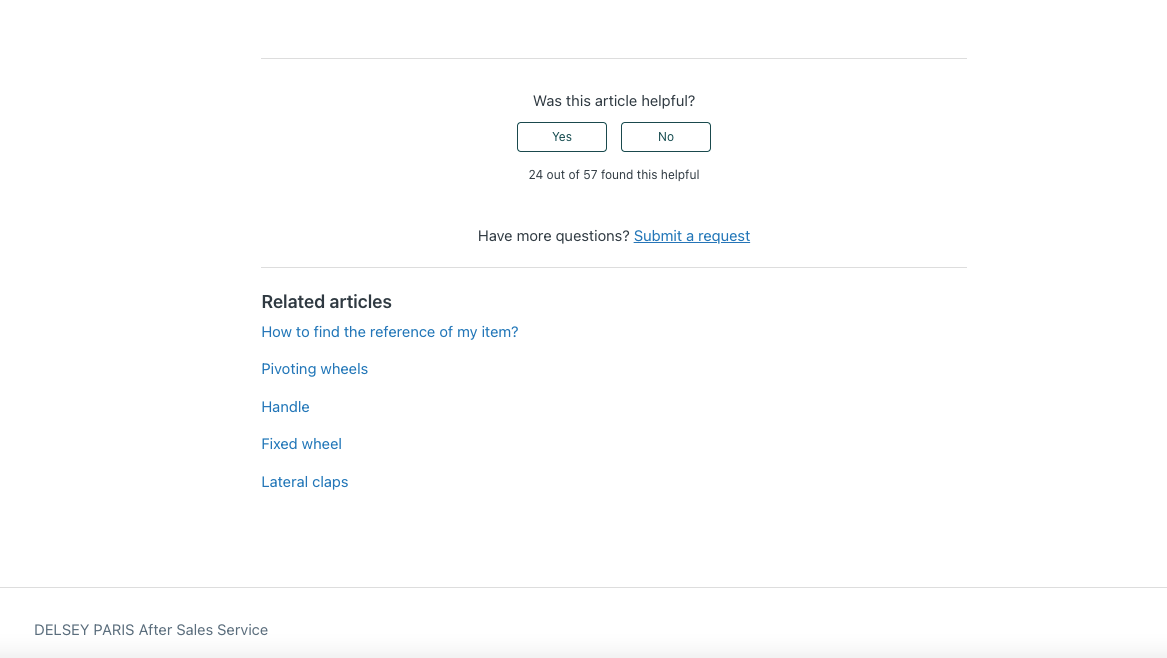
Keep Reading: Deliver An Amazing Post Purchase Experience: 17 Ideas (& Examples)
Most of us are aware that buyer guides are all the rage in eCommerce, especially during peak shopping season.
But for luggage conversion optimization, you’ll have to treat them like evergreen content that nurtures the larger purchase experience — no matter what time of year it is.
👉 Create guide content that resolves immediate packing troubles — whether it’s about rolling, folding or compressing items into their chosen product, use cases can help shoppers visualize how it’ll be for them to use it in the long run. Feature snippets on short travel tips as well as tips on longer duration, so that sub-segments also see value in these buyer guides.
👉 Create case studies on your bestselling travel & luggage products — if you have a large catalog, start with the top 5 or 6 products and go in-depth into the case story. Preferably, pick a customer segment that clearly buys the most of this product, to represent the case story.
eCommerce luggage brand TUMI targets shoppers across markets and airlines, so it’s natural that they feature a guide that shows carry-on policies across carriers. This a quick and relevant access for shoppers who’re serious about buying from the brand:
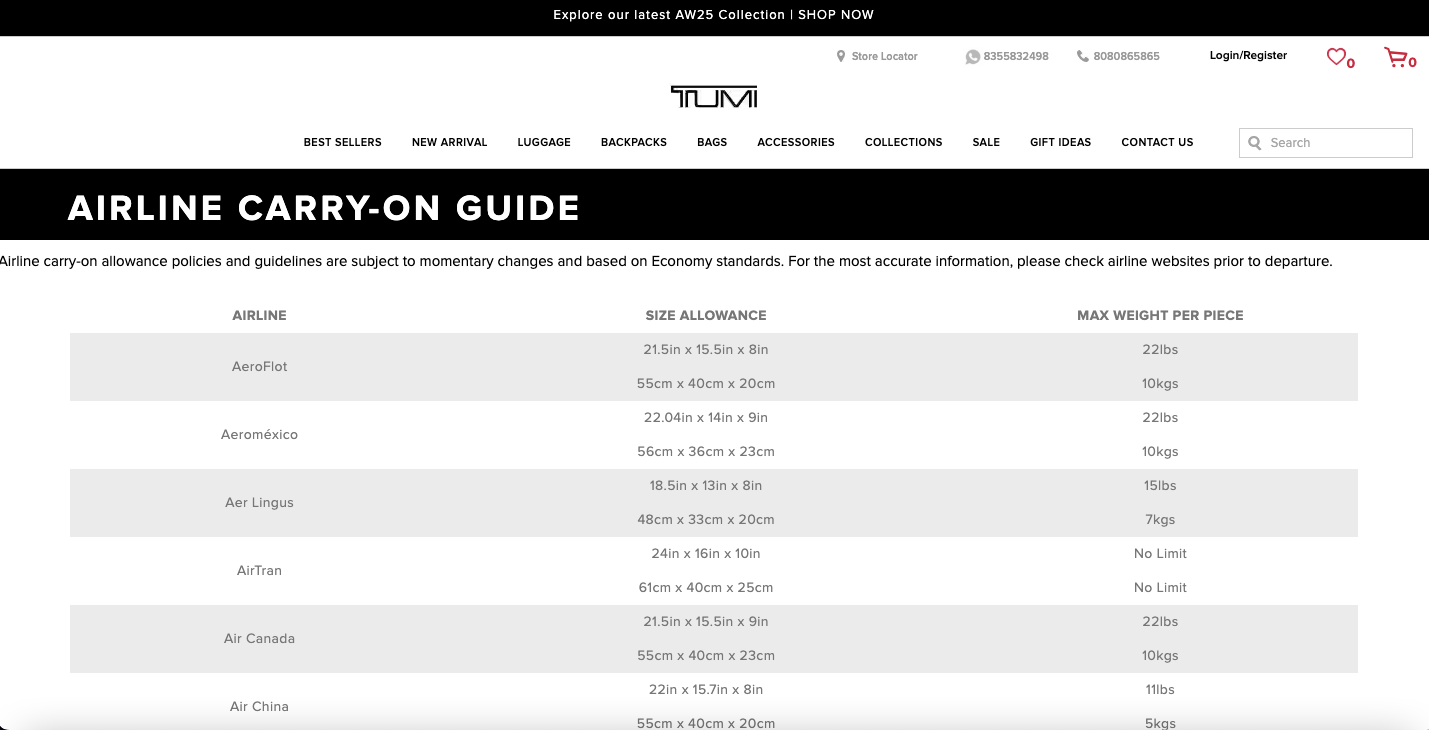
Ask any traveler, and they’ll tell you, “I wouldn’t mind getting my favorite piece of luggage as a gift.”
Which is why it’s imperative that you look at your data and run seasonal ads — and to match the latter, set up landing pages specifically geared for gifting.
👉 Create landing pages on “curated collections” — this is the fastest way of establishing authority with an experienced, high-intent travel luggage buying audience. To make it more effective, bring up press mentions and collaboration information if you’ve been doing work with other designers or brands.
👉 Highlight segment preferences on the landing page clearly — if you’re targeting 2 to 3 segments through the landing page, ensure each persona sees what they like in terms of weight, durability, compartments & color. However, if you’re indeed targeting multiple segments, ensure you pick only a product or two to highlight for each of them — this way cognitive load stays in check.
👉 Set up sections on “ready to gift” products — while usually dispatch may take up to a week during peak season, maintain a line of products that are “ready to gift” and “ready to ship”. This targets last-minute buyers more effectively.
eCommerce luggage brand Level8 starts with the gifting revelry way earlier than its competitors. At the start, they turn their homepage into the “gifting hub” with multiple segues for multiple segments so that product discovery becomes easier:
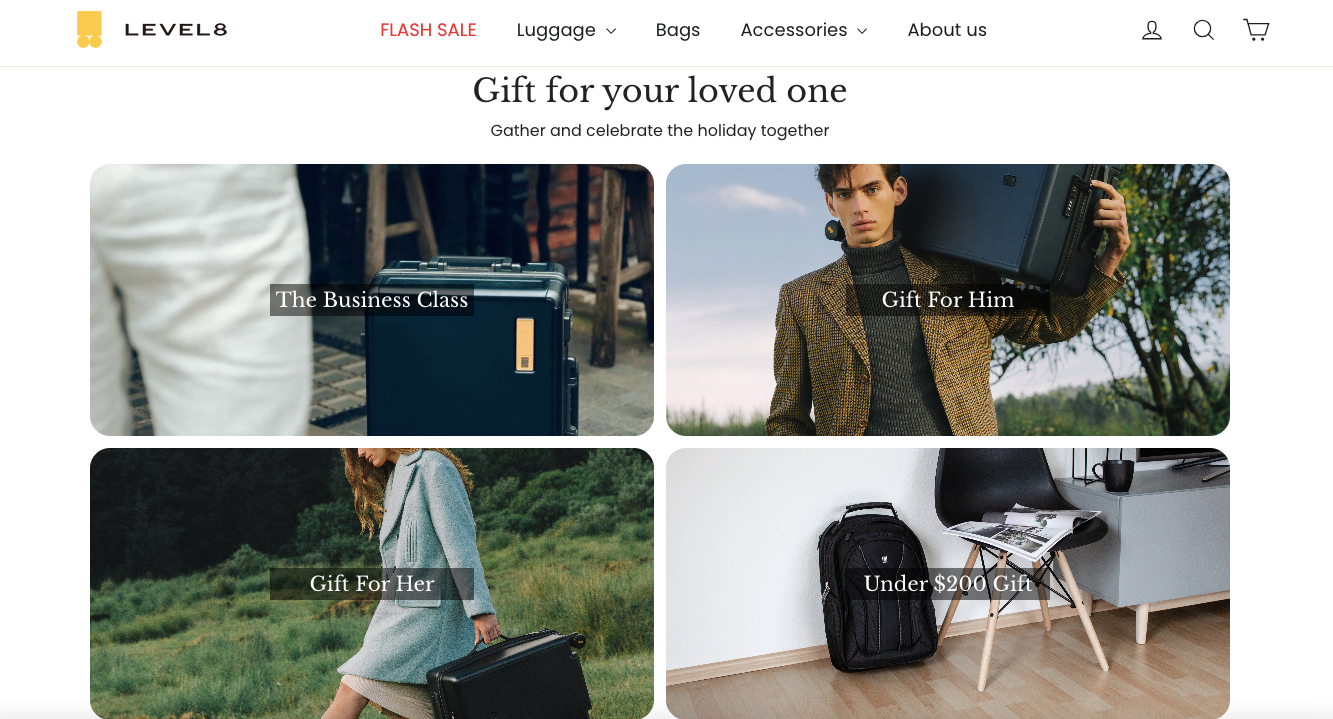
Unlike in other eCommerce niches, upsells and cross-sells across luggage stores can be easily ignored.
This is because price is a chief factor on the baggage buyer’s mind — and any additional recommendations need to make them believe a “heightened” experience awaits.
👉 Upsell / cross-sell with a unified price — instead of positioning separate products as add-ons, show a single product price and another one when the most relevant add-ons are included. Look at your buyers’ data and see which add-ons are most frequently bought together (is it luggage tags & TSA approved locks? Or packing cubes & travel organizers?)
👉 Show scenario-based recommendations — that’s because no two travelers will think alike. So let’s say if you’re trying to upsell to a shopper intent on a 21’’ carry-on luggage, show a “Heading on a 10-day trip? Consider the 25” spinner to pack more comfortably” add-on nudge.
While luggage brand Solgaard does make its add-ons seem viable and relevant through their compatibility with the main product, it’s the pricing and placement that help them bag conversions. They ensure a lot of new visitor objections are resolved before the add-on suggestion even appears:
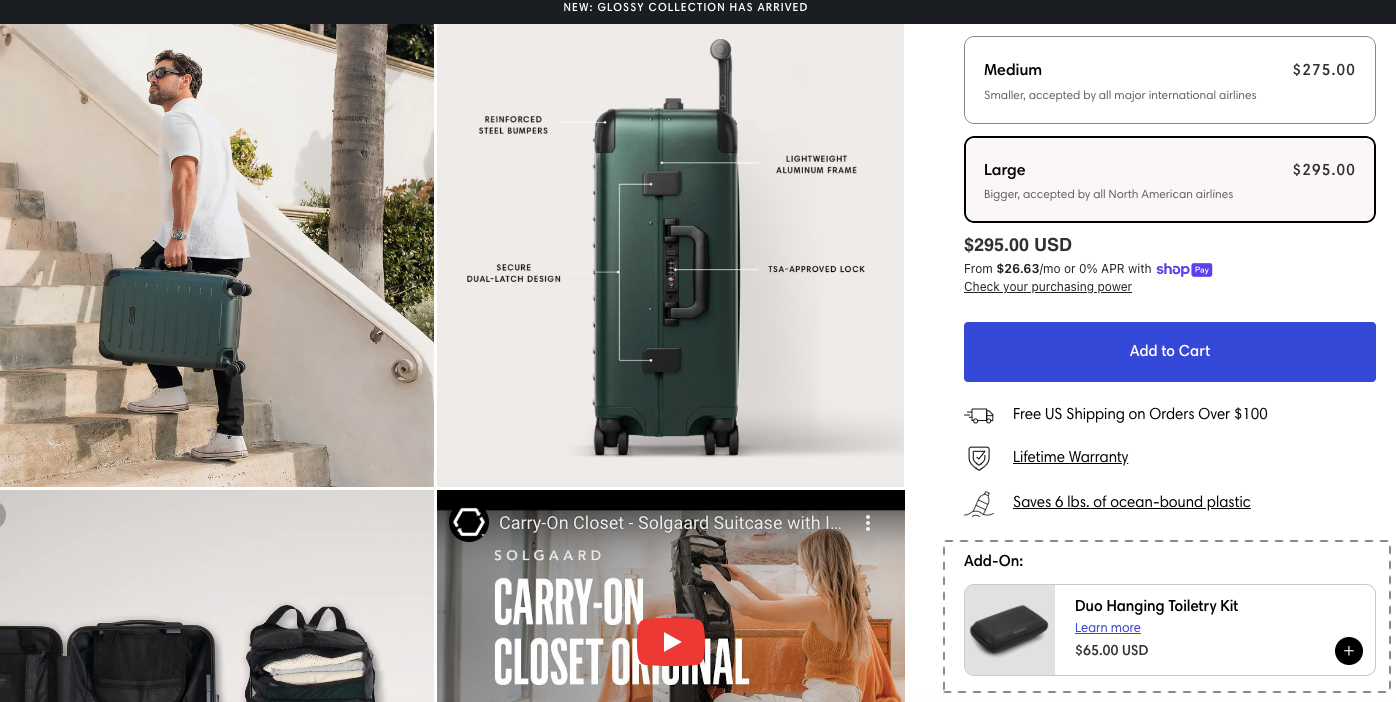
And what’s better, the brand shows additional info on the add-on through a super neat modal that only focuses on the most immediate buyer worries like warranty and internal structure. This lets potential customers make a quicker add to cart decision:
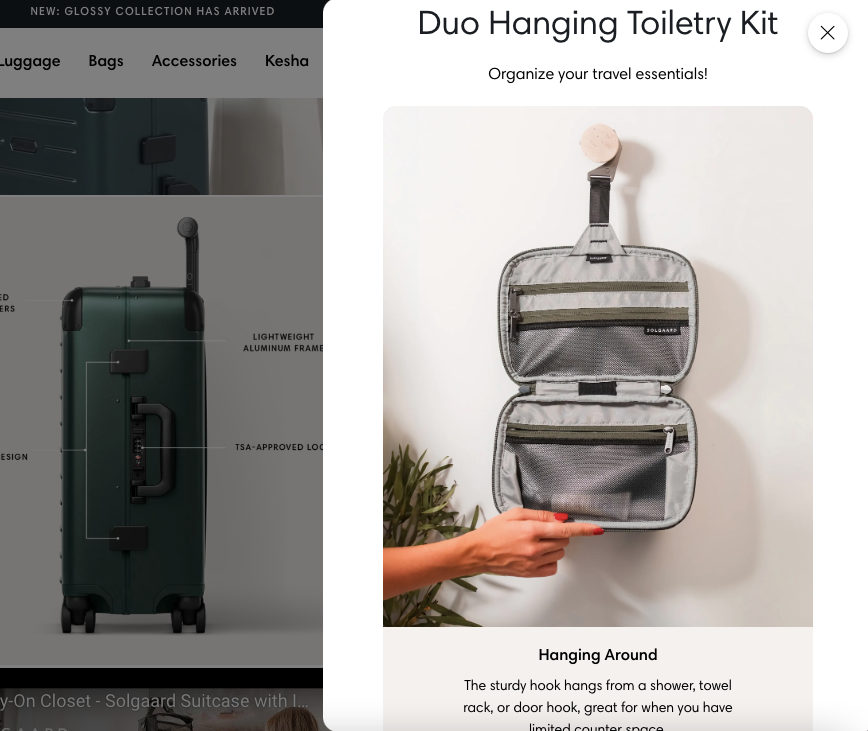
Last year, one luggage brand that had signed up for our free audit lamented that they were innovating a lot by coming up with at least 3 new launches / upgrades every year.
And yet, their conversions were not seeing a significant increase around these product launches.
What we found out was critical: though the store boasted of something new, there were not many ways for shoppers to deep-dive into it apart from the product page.
👉 Integrate visual features like 360° views — alongside the storytelling that such a launch blog may carry, including the behind-the-scenes of the manufacturing or material sourcing, visualization can make it more compelling for serious buyers.
👉 Show a section on user generated content — did you have a first line of existing buyers / micro-influencers test this launch product out? Show a wall of static images & review snippets or short videos of unpacking the product.
👉 Implement a powerful CTA — you can either layer the blog with up to 3 CTAs (one at the beginning, one in the middle and one right at the end) or if it’s a short piece of content, feature a super bold CTA at the end of it.
Luggage brand Antler has intelligently reserved a section of their store blog to “What’s New”. This allows the brand to create engaging content around specific products and talk about the design choices behind it. What the brand also does well is to surface accessories and add-ons on these blogs. Last but not the least, they feature a CTA like “Shop the Collection” at the end of the piece:
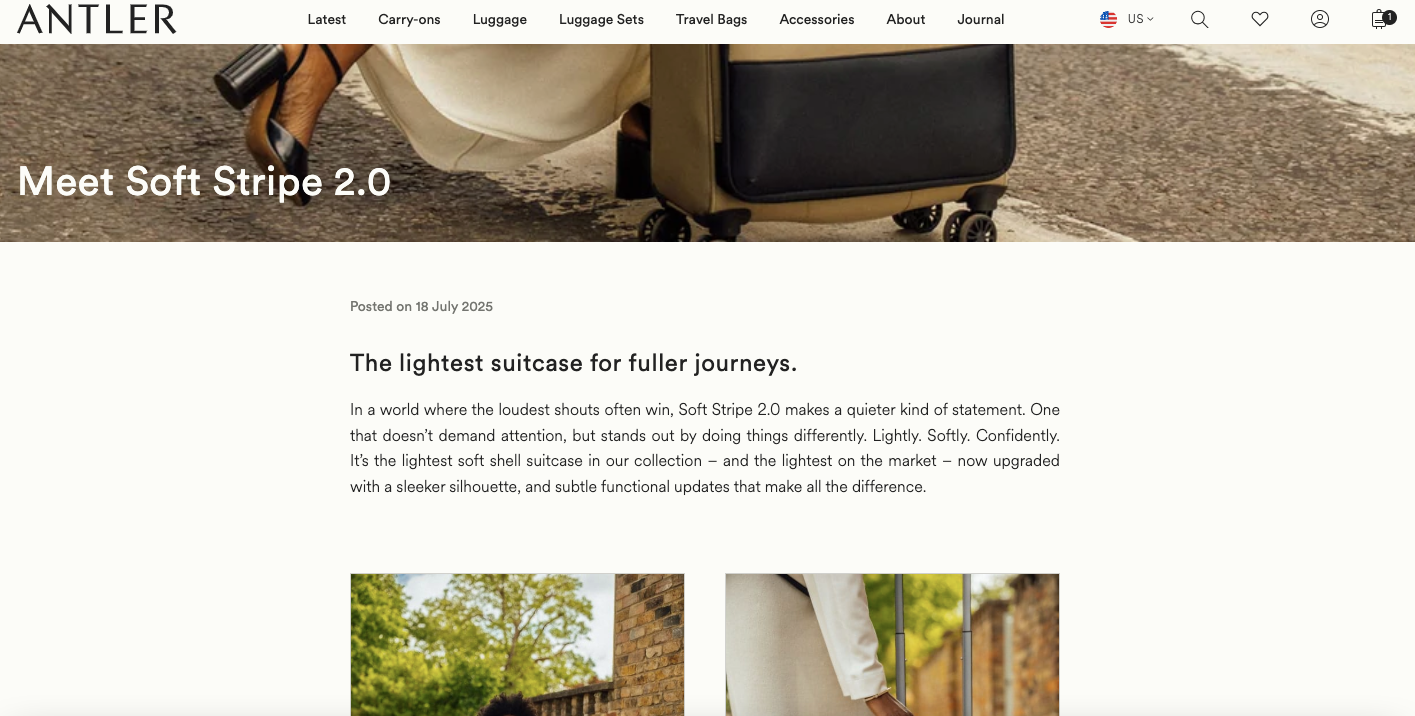
This is a key A/B test to perform if you run an eCommerce luggage store.
The reason is simple: to assess if a narrow focus brings in more high-intent customers.
But for it to work, there are a few aspects that need to be especially optimized.
👉 Get user segmentation & personalization right — the idea is to show the right homepage content to the right segment (for example, a first-time visitor would want to see key features like “10 year warranty” and “tested airline compliance”). You can set this up right through behavior-based triggers (did they find you on one of the social channels?), geo or device-based location (are they visiting from South Korea?) and even loyalty status (are they logged into their account at the moment?)
👉 Prioritize visual storytelling — since you’re spotlighting a single product, make sure you show visual comparisons (with the luggage resting against different backgrounds) as well as use cases (pick the most relevant 3 to 4, so that you can also tap into the buying to gift mindset).
eCommerce luggage brand Halfday often takes this approach, especially when they launch a new collection. To make the hero header compelling, they use a GIF on loop alongside a USP-driven headline and simple but bold CTA.
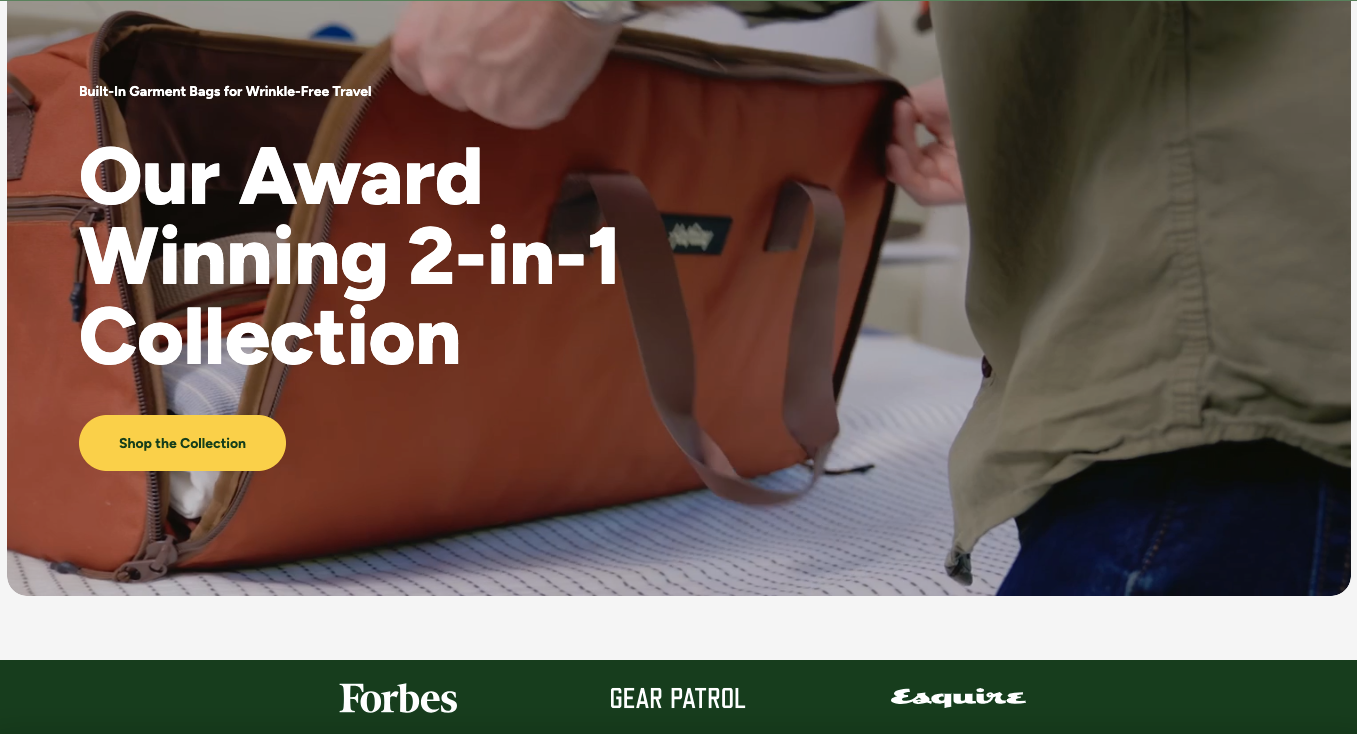
Along the homepage, they offer a breakdown of the most key products within the collection, and also ensure various kinds of social proof, including press mentions as well as review snippets. They also show a great upgrade nudge for shoppers who’re willing to spend more:
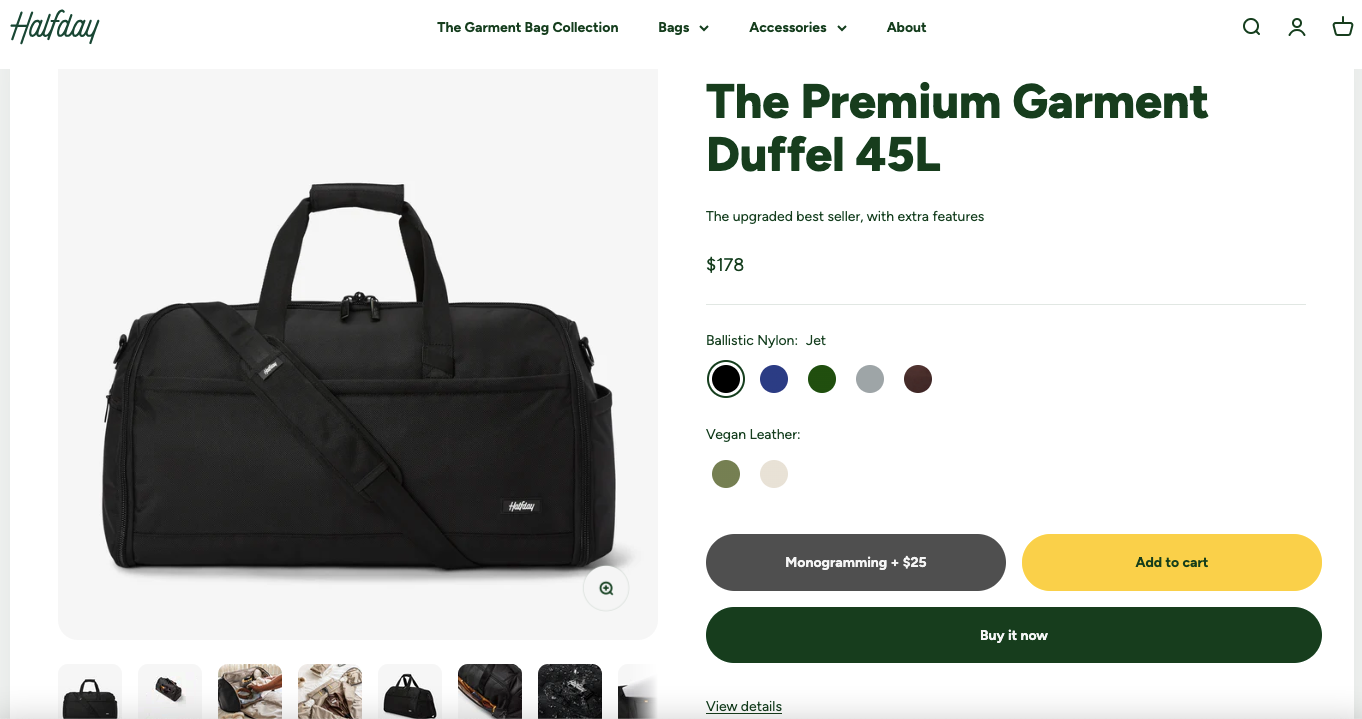
To get this luggage conversion tactic right, it’s imperative that you sift through your data and find out which segments have habitually come back to buy more.
This is a necessary exercise not just to retain customers but also to drive lifetime value on your luggage store.
👉 Offer discounts on add-ons to repeat buyers — while add-ons are perfectly justified, they usually don’t carry as much appeal for new buyers. For older customers though, they carry real value, especially when you push them through a discount along with messaging like: “Add our TSA-approved lock at 20% off when purchasing your second bag.”
👉 Pick loyalty milestones to pitch the discounts — these create additional emotional appeal in the minds of shoppers, and also positions the discount as a desirable thing. Feature a nudge on the product page especially when you’re running your holiday marketing campaigns.
👉 Call out discounted segments clearly — do you feature discounts for army veterans? Or social workers? That ought to come out across the store especially in key positions like the header and footer.
Carry-on baggage brand Antler runs discounts for segments including airline staff, students as well as healthcare workers and teachers. The brand features clear links to these discount pages:
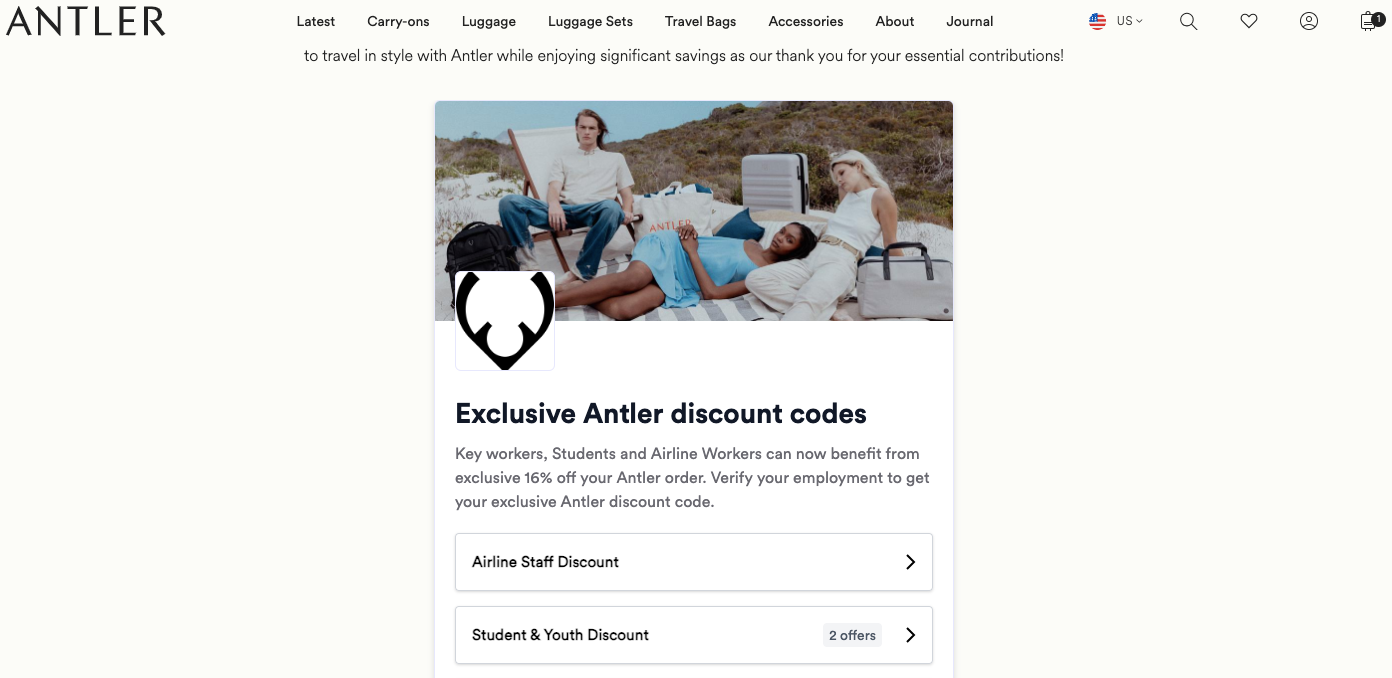
Though travel interest is known to differ by seasons, buying intent doesn’t ever fully disappear. And this is why what you do to market your store year-round can have a huge impact on conversions.
✌A recommendation quiz: Since luggage is a slightly more complex niche, you’d want to pay attention to the nature of questions that truly helps narrowing down on real-time shopper preferences. Feel free to tweak the quiz for a sale event that has a distinct theme, whether it’s Veteran’s Day or 4th of July. And the good news is that the quiz can be part of your store navigation or even “Link in Bio” on Instagram, among many other ways of applying it.
✌Run social contests to gather highly relevant UGC: Think of this as a double-layered luggage conversion strategy because it creates marketing hype in two stages. First, when you announce the contest and a relevant prize (let’s say your bestselling backpack that’s relaunching with an upgrade). And second, when the submissions open up and entries are up for assessment. The win-win? Lookalike audiences get to know your brand because of the contest virality and existing customers get a fresh reason to engage deeply with your brand.
✌Send lifecycle emails based on travel planning behavior: In other words, don’t just limit these emails to purchase events. The idea is to nurture luggage shoppers not only when they have active intent to buy, but also when they’re dreaming and planning. What we’ve seen to work really well for Engage clients is to send targeted tips that segment the conversion funnel clearly — tips like “5 things to pack for long-haul flights”.
✌Create experience-led content & link to relevant product collections: Travel shoppers love stories. Whether they’re about the places that are marked in their diaries or those they’ve never heard of. In fact, the perceptive standing of a luggage brand often goes up when it’s able to offer value-add content first and then relevantly link it to limited edition product collections or bestselling add-on accessories.
✌Heighten engagement through your luggage loyalty program: If you incentivize members only when they purchase, you run the risk of pushing your luggage loyalty program into a longer lifecycle of engagement. Ditch that and start offering points on photo shares that include your products, use of your branded hashtags when people travel to different destinations and when they refer friends / family who actively travel.
Since luggage is amongst those niches where the consideration to conversion lifecycle can be significantly long, there are in-store elements that you’d specifically want to optimize. Here are the 5 top ones we’ve seen create friction or trust during audits:
👉 Fit confidence: When shoppers don’t find a clear peek into aspects like size, weight and airport compatibility, there are higher chances of them bouncing. So, luggage stores that are able to feature tools like interactive size comparison (“Compare to a carry-on allowed by Delta”) and airline-specific filters, they see better conversions.
👉 Durability proof: Luggage buyers don’t mind high-ticket products as long as they have long-term potential. But if a store isn’t able to clearly offer call-outs on materials and the behind-the-scenes manufacturing process, conversions can easily suffer.
👉 Use case personalization: As literal as it sounds, luggage is not one-size-fits-all. And that means stores that are able to target shoppers through various use cases, win big. Whether it’s your “shop by trip” filters and navigators or product pages that break down use cases into infographics, this is a key area that can enhance luggage conversion rates.
👉 In-cart clarity: Once a luggage buyer is in the cart, their mind’s on delivery timelines, if a coupon can be applied (as promised) and if the return window is mentioned. Across travel store businesses, we’ve tested an in-cart shipping calculator, for example, and it has always helped these brands to create instant in-cart trust & clarity.
👉 Post-purchase support & reassurance: Repairability, aftercare and the access to instant & sustained support are some of the reasons luggage shoppers keep coming back to a specific brand. Make sure your microcopy & FAQ across the store cover top-of-the-mind customer objections while citing policies & customer care support digits.
98% of visitors who visit an eCommerce site—drop off without buying anything.
Why: user experience issues that cause friction for visitors.
And this is the problem Convertcart solves.
We've helped 500+ eCommerce stores (in the US) improve user experience—and 2X their conversions.
How we can help you:
Our conversion experts can audit your site—identify UX issues, and suggest changes to improve conversions.